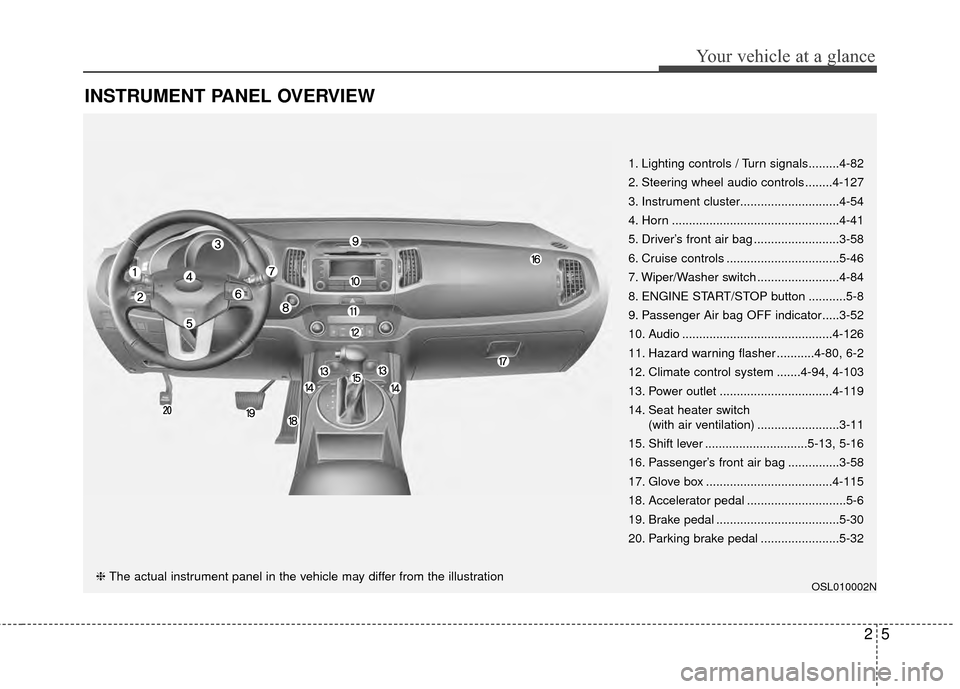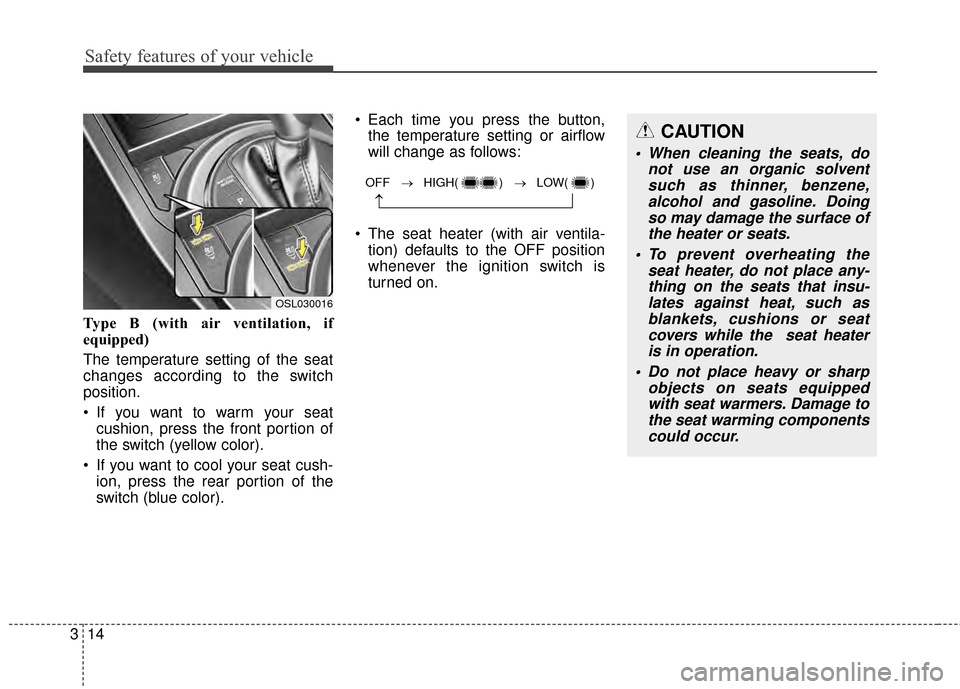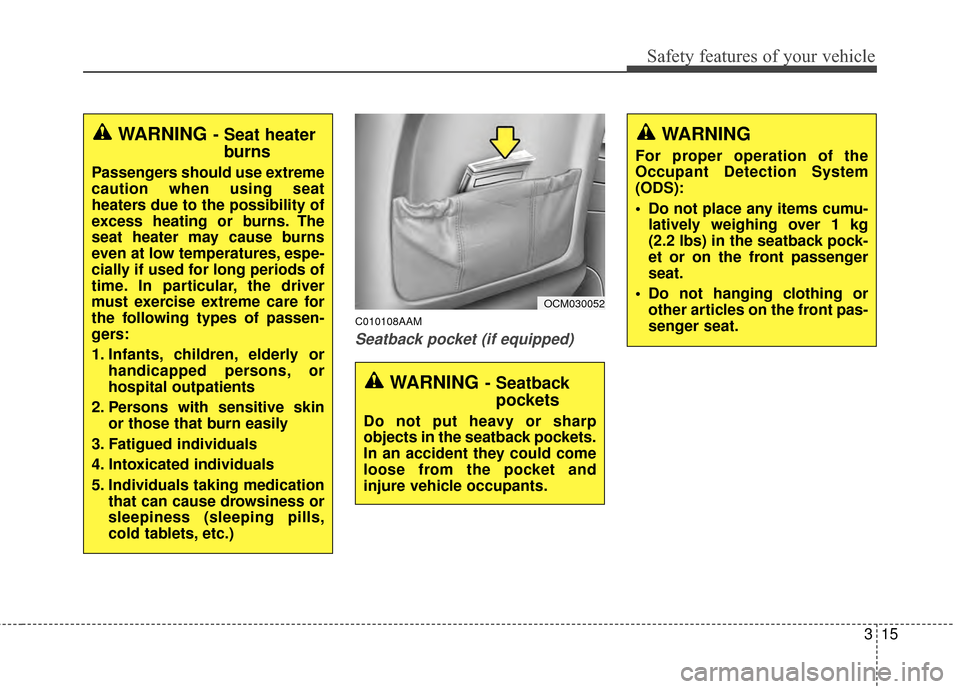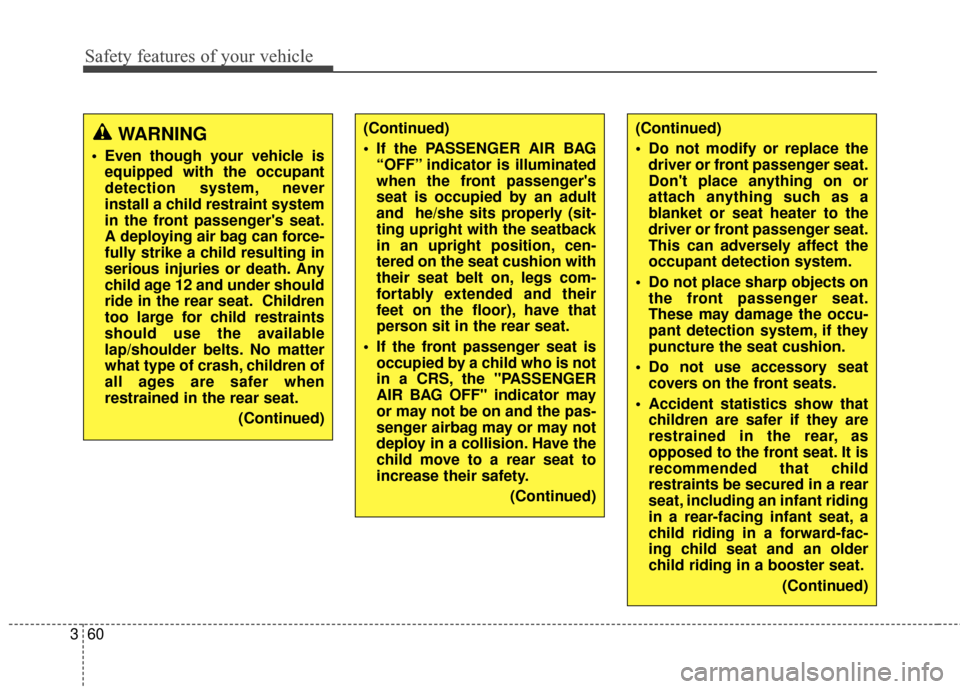Page 14 of 457

25
Your vehicle at a glance
INSTRUMENT PANEL OVERVIEW
OSL010002N
1. Lighting controls / Turn signals.........4-82
2. Steering wheel audio controls ........4-127
3. Instrument cluster.............................4-54
4. Horn .................................................4-41
5. Driver’s front air bag .........................3-58
6. Cruise controls .................................5-46
7. Wiper/Washer switch ........................4-84
8. ENGINE START/STOP button ...........5-8
9. Passenger Air bag OFF indicator.....3-52
10. Audio ............................................4-126
11. Hazard warning flasher ...........4-80, 6-2
12. Climate control system .......4-94, 4-103
13. Power outlet .................................4-119
14. Seat heater switch(with air ventilation) ........................3-11
15. Shift lever ..............................5-13, 5-16
16. Passenger’s front air bag ...............3-58
17. Glove box .....................................4-115
18. Accelerator pedal .............................5-6
19. Brake pedal ....................................5-30
20. Parking brake pedal .......................5-32
❈ The actual instrument panel in the vehicle may differ from the illustration
Page 17 of 457
Safety features of your vehicle
23
Front seat
(1) Forward and backward
(2) Seatback angle
(3) Seat cushion height (Driver’sseat)
(4) Lumbar support (Driver’s seat)*
(5) Seat heater (with air ventilation)*
(6) Headrest
2nd row seat
(7) Seatback folding
(8) Headrest
(9) Armrest
(10) Seat heater*
* if equipped
SEATS
OSL030001
Manual seat
Power seat
*
* *
*
*
Page 28 of 457
313
Safety features of your vehicle
C010107AUN
Front seat heater (if equipped)
Type A
The seat heater is provided to warm
the front seats during cold weather.
With the ignition switch in the ON
position, push either of the switches
to warm the driver's seat or the front
passenger's seat.
During mild weather or under condi-
tions where the operation of the seat
heater is not needed, keep the
switches in the OFF position. Each time you push the button, the
temperature setting of the seat will
change as follows :
The seat heater defaults to the OFF position whenever the ignition
switch is turned on.
✽ ✽ NOTICE
With the seat heater switch in the
ON position, the heating system in
the seat turns off or on automatical-
ly depending on the seat tempera-
ture.
OSL030013
OFF → HIGH( ) → LOW( )
→
Page 29 of 457

Safety features of your vehicle
14
3
Type B (with air ventilation, if
equipped)
The temperature setting of the seat
changes according to the switch
position.
If you want to warm your seat
cushion, press the front portion of
the switch (yellow color).
If you want to cool your seat cush- ion, press the rear portion of the
switch (blue color). Each time you press the button,
the temperature setting or airflow
will change as follows:
The seat heater (with air ventila- tion) defaults to the OFF position
whenever the ignition switch is
turned on.
OSL030016
OFF → HIGH( ) → LOW( )
→
CAUTION
When cleaning the seats, do not use an organic solventsuch as thinner, benzene,alcohol and gasoline. Doingso may damage the surface ofthe heater or seats.
To prevent overheating the seat heater, do not place any-thing on the seats that insu-lates against heat, such asblankets, cushions or seatcovers while the seat heateris in operation.
Do not place heavy or sharp objects on seats equippedwith seat warmers. Damage tothe seat warming componentscould occur.
Page 30 of 457

315
Safety features of your vehicle
C010108AAM
Seatback pocket (if equipped)
OCM030052
WARNING- Seatbackpockets
Do not put heavy or sharp
objects in the seatback pockets.
In an accident they could come
loose from the pocket and
injure vehicle occupants.
WARNING- Seat heaterburns
Passengers should use extreme
caution when using seat
heaters due to the possibility of
excess heating or burns. The
seat heater may cause burns
even at low temperatures, espe-
cially if used for long periods of
time. In particular, the driver
must exercise extreme care for
the following types of passen-
gers:
1. Infants, children, elderly or
handicapped persons, or
hospital outpatients
2. Persons with sensitive skin or those that burn easily
3. Fatigued individuals
4. Intoxicated individuals
5. Individuals taking medication that can cause drowsiness or
sleepiness (sleeping pills,
cold tablets, etc.)
WARNING
For proper operation of the
Occupant Detection System
(ODS):
Do not place any items cumu-latively weighing over 1 kg
(2.2 lbs) in the seatback pock-
et or on the front passenger
seat.
Do not hanging clothing or other articles on the front pas-
senger seat.
Page 36 of 457

321
Safety features of your vehicle
Rear seat armrest
To use the armrest, pull it forward
from the seatback.
Rear seat heater (if equipped)
The seat heater is provided to warm
the rear seats during cold weather.
With the ignition switch in the ON
position, push either of the switches
to warm rear seats.
During mild weather or under condi-
tions where the operation of the seat
heater is not needed, keep the
switches in the "OFF" position.
✽ ✽NOTICE
With the seat heater switch in ON
position, the heating system in the
seat turns off or on automatically
depending on the seat temperature.
CAUTION
When cleaning the seats, do
not use an organic solventsuch as thinner, benzene,alcohol and gasoline. Doingso may damage the surface ofthe heater or seats.
To prevent overheating the seat heater, do not place any-thing on the seats that insu-lates against heat, such asblankets, cushions or seatcovers while the seat heateris in operation.
Do not place heavy or sharp objects on seats equippedwith seat warmers. Damage tothe seat warming componentscould occur.
OSL030019OSL030020
Page 37 of 457
Safety features of your vehicle
22
3
WARNING- Seat heater
burns
Passengers should use extreme
caution when using seat
heaters due to the possibility of
excess heating or burns. The
seat heater may cause burns
even at low temperatures, espe-
cially if used for long periods of
time. In particular, the driver
must exercise extreme care for
the following types of passen-
gers:
1. Infants, children, elderly or
handicapped persons, or
hospital outpatients
2. Persons with sensitive skin or those that burn easily
3. Fatigued individuals
4. Intoxicated individuals
5. Individuals taking medication that can cause drowsiness or
sleepiness (sleeping pills,
cold tablets, etc.)
Page 75 of 457

Safety features of your vehicle
60
3
WARNING
Even though your vehicle is
equipped with the occupant
detection system, never
install a child restraint system
in the front passenger's seat.
A deploying air bag can force-
fully strike a child resulting in
serious injuries or death. Any
child age 12 and under should
ride in the rear seat. Children
too large for child restraints
should use the available
lap/shoulder belts. No matter
what type of crash, children of
all ages are safer when
restrained in the rear seat.
(Continued)
(Continued)
Do not modify or replace thedriver or front passenger seat.
Don't place anything on or
attach anything such as a
blanket or seat heater to the
driver or front passenger seat.
This can adversely affect the
occupant detection system.
Do not place sharp objects on the front passenger seat.
These may damage the occu-
pant detection system, if they
puncture the seat cushion.
Do not use accessory seat covers on the front seats.
Accident statistics show that children are safer if they are
restrained in the rear, as
opposed to the front seat. It is
recommended that child
restraints be secured in a rear
seat, including an infant riding
in a rear-facing infant seat, a
child riding in a forward-fac-
ing child seat and an older
child riding in a booster seat.
(Continued)(Continued)
If the PASSENGER AIR BAG“OFF” indicator is illuminated
when the front passenger's
seat is occupied by an adult
and he/she sits properly (sit-
ting upright with the seatback
in an upright position, cen-
tered on the seat cushion with
their seat belt on, legs com-
fortably extended and their
feet on the floor), have that
person sit in the rear seat.
If the front passenger seat is occupied by a child who is not
in a CRS, the "PASSENGER
AIR BAG OFF" indicator may
or may not be on and the pas-
senger airbag may or may not
deploy in a collision. Have the
child move to a rear seat to
increase their safety.
(Continued)